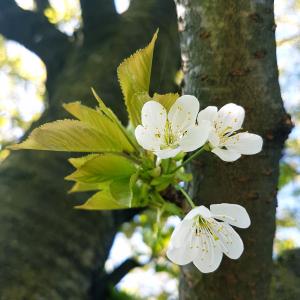The American Straw Tree: Nature's Medicinal Treasure
The American straw tree (Euptelea polyandra), though less known than many medicinal plants, holds a wealth of botanical and therapeutic significance. This deciduous tree, celebrated for both its ecological role and medicinal properties, is native to specific regions in North America. Its unique biology and chemical composition make it a subject of interest for both botanists and those in the field of natural medicine.
Botanical Description
The American straw tree, which belongs to the Eupteleaceae family, typically grows to heights of 20-30 feet. It has a distinctive appearance, with smooth, gray bark that becomes rough and furrowed with age. The tree's leaves are broad, with a simple, alternate arrangement and finely serrated edges. In spring, the tree produces small, inconspicuous flowers which lack petals but have prominent stamens, giving the tree a unique visual appeal. These flowers develop into small, winged fruits that disperse by wind, aiding in the tree’s propagation.
Habitat and Distribution
The natural habitat of the American straw tree spans temperate regions of the United States, primarily in the southeastern states. It thrives in rich, well-drained soils and is often found in mixed hardwood forests, along stream banks, and in areas with moist, fertile ground. The tree prefers partial to full sunlight and can adapt to a range of soil types, though it performs best in slightly acidic to neutral pH conditions.
Its ecological role is significant; it contributes to the forest understory's biodiversity and provides shelter and food for various wildlife species. The winged seeds are a source of food for birds and small mammals, while the dense foliage offers nesting sites.
Medicinal Uses
The American straw tree's medicinal value is derived from various parts of the plant, including its leaves, bark, and roots. Traditional uses by Native American tribes and early settlers have laid the groundwork for contemporary medicinal applications. Here's how medicinal ingredients are sourced from the American straw tree:
1. Bark Extracts
The bark of the American straw tree is known for its astringent and anti-inflammatory properties. To harvest the medicinal ingredients from the bark, the following steps are typically followed:
-
Harvesting: The bark is carefully stripped from mature trees, usually in spring or fall when the sap is running, making it easier to peel.
-
Drying: Once harvested, the bark is dried in a shaded, well-ventilated area to prevent mold and degradation of its active compounds.
-
Processing: Dried bark is then ground into a powder or used to make tinctures. It is often used in poultices or teas for its astringent properties, which help in treating wounds, inflammation, and digestive issues.
2. Leaf Extracts
The leaves of the American straw tree contain compounds that have been used for their potential antioxidant and anti-inflammatory effects:
-
Collection: Leaves are typically collected during the growing season when they are fully expanded and rich in phytochemicals.
-
Preparation: Fresh leaves can be used to make infusions or dried and stored for future use. They are often brewed into teas or used in extracts that can be applied topically or ingested.
-
Uses: Leaf extracts are traditionally used to alleviate symptoms of colds, fevers, and skin irritations. Recent studies suggest potential benefits in managing oxidative stress and inflammation.
3. Root Extracts
The roots of the American straw tree are less commonly used but have notable medicinal properties:
-
Harvesting: Roots are generally harvested in the fall, allowing the plant to store energy during the growing season.
-
Processing: After cleaning and drying, the roots are often used to make decoctions. The root extracts have been used historically to address issues such as gastrointestinal distress and as a general tonic.
Active Compounds and Therapeutic Potential
The medicinal properties of the American straw tree can be attributed to a variety of phytochemicals found within its tissues. These include tannins, flavonoids, and saponins, which contribute to its therapeutic effects:
-
Tannins: Known for their astringent qualities, tannins help in tightening tissues and reducing inflammation, making them useful in wound healing and treating diarrhea.
-
Flavonoids: These compounds have antioxidant properties, helping to neutralize free radicals and reduce oxidative stress, potentially lowering the risk of chronic diseases.
-
Saponins: Saponins exhibit anti-inflammatory and immune-modulating effects, which can be beneficial in managing inflammatory conditions and supporting overall immune health.
Contemporary Research and Uses
Modern research is beginning to explore the potential of the American straw tree beyond its traditional uses. Studies are investigating its bioactive compounds for their potential roles in treating conditions like inflammation, oxidative stress, and possibly even cancer. Its extracts are being evaluated for their ability to inhibit microbial growth, suggesting potential applications in developing new antibiotics or antifungal agents.
Cultivation and Conservation
Given its medicinal potential and ecological importance, the American straw tree is also a candidate for conservation efforts. Its propagation through seed dispersal can be supplemented by human-led efforts to cultivate it in botanical gardens and arboreta. This not only preserves the species but also provides a sustainable source for medicinal use.
Cultivation practices include:
-
Site Selection: Choosing locations that mimic the tree’s natural habitat, with appropriate soil moisture and sunlight conditions.
-
Planting: Seeds or saplings are planted in well-prepared soil and monitored for growth and health.
-
Maintenance: Regular care involves monitoring for pests, ensuring adequate water supply, and protecting young plants from harsh environmental conditions.
Conclusion
The American straw tree (Euptelea polyandra) is a fascinating example of how traditional knowledge and modern science can intersect to reveal the medicinal potential of native flora. From its astringent bark to its antioxidant-rich leaves, this tree offers a variety of therapeutic compounds that can contribute to natural health solutions. As research continues to uncover its secrets, the American straw tree stands as a testament to the rich botanical diversity and the medicinal potential found in North America's native landscapes.





















